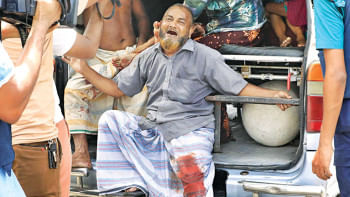Focus shifting from power generation to transmission

The government has shifted its focus from power generation to transmission and distribution as the sector is struggling with overcapacity even though consumers are yet to receive a credible supply of electricity.
Because of the overcapacity, the country has to fork out a hefty amount to meet the cost of unutilised electricity.
This prompted the government to allocate funds in the budget for the next fiscal year for several large projects to improve the power transmission and distribution infrastructure.
Of the Tk 27,484 crore allocated for the power, energy and mineral resources ministry, the Power Division received about Tk 22,000 crore.

There were no allocations for new projects for the generation system and only the ongoing plants have received new funds, said Mohammad Hossain, director-general of the Power Cell, an agency under the Power Division.
"Power generation is now in surplus. So, the government has put emphasis on transmission and distribution in the budget," he added.
Previously, about 80 per cent of the allocation used to go to the projects for generation and the rest for transmission. But for the next fiscal year, about 60 per cent of the allocation is going to transmission and distribution projects.
Under the transmission and distribution projects in the upcoming fiscal year, new distribution substations will be built, the old lines will be replaced with new ones, the wooden boards will be changed, and the capacity of transformers will be upgraded.
The Bangladesh Rural Electrification Board (BREB) is set to implement many distribution projects which will help reduce power outages in rural areas.
A project involving Tk 4,000 crore has been taken under the BREB to develop the distribution network.
The Bangladesh Power Development Board (BPDB), Dhaka Power Distribution Company (DPDC), Dhaka Electric Supply Company, West Zone Power Distribution Company, and Northern Electricity Supply Company also got funds to modernise their distribution systems.
DPDC received Tk 3,051 crore from the Annual Development Programme to expand and strengthen the power system network. Under the project, the overhead electric cables will go underground.
The government has made allocations to develop the transmission system to evacuate electricity from the Rooppur Nuclear Power Plant and Matarbari and Payra power plants.
However, the budget for FY2021-22 is not in line with the government plan to phase out rental and the quick rental power plants to bring down the expenses stemming from growing capacity charges.
Khondaker Golam Moazzem, research director at the Centre for Policy Dialogue (CPD), welcomed the higher budget for the transmission and distribution systems.
"But, the transmission and distribution systems have not got as much importance as they should have got, and the tendency to spend money on generation is continuing despite the overcapacity," he said. "For the lack of adequate investment in the transmission and distribution, consumers are experiencing power cuts across the country."
The 600-megawatt Matarbari ultra super-critical coal-fired power project was given an ADP allocation of Tk 6,162 crore and the Rooppur Nuclear Power Plant Tk 18,426 crore.
Although the allocation for the Rooppur plant falls under the science and technology ministry, it is still for power generation.
"The allocation for generation is still higher than the funds set aside for transmission and distribution, which is disappointing," Moazzem added.
According to the CPD, 62 per cent of the ADP outlay for the power sector went to generation.
The power sector is struggling with overcapacity. More than 48 per cent of the generation capacity remained unused on June 2. As a result, BPDB needs a significant amount of subsidy to meet its cost.
For the next fiscal, the subsidy provided for the energy and power sector has remained unchanged at Tk 9,000 crore.
The subsidy will likely mean that the BPDB will not need to seek permission from the Bangladesh Energy Regulatory Commission to raise the power tariff. This is not desirable during the crisis, the CPD said in its budget analysis.
Because of the inefficacy in the power sector and overcapacity, the government has to pay the capacity charges, forcing it to subsidise the sector.
"If they don't get the subsidy, they have to increase the power tariff. If the quick rental plants and inefficient plants are phased out, this problem would be solved," Moazzem said.
"We expect a specific announcement from the power ministry on how these quick rental power plants will be phased out, the old plants will be shut, and the new financing on coal-based power plants will be suspended," he added.
The government has a commitment to retire fossil-fuel based power generation and is moving towards clean-energy based power generation.
"But, the budget makes no such indication," Moazzem said.
Industry insiders say extreme overcapacity is undermining the government's success in the power sector.
At present, the installed capacity was 25,227 MW as of June 3, according to the Power Cell. The maximum power generation on the day was 13,014 MW. In Bangladesh, the highest 13,792 MW of power was generated on April 27.
The rates of overcapacity were found to be 59 per cent, 46 per cent, and 49.8 per cent in June FY18, FY19 and FY20, respectively.
The highest overcapacity was recorded in January and March of 2020, at 63.3 per cent and 62.5 per cent, respectively.
The excess capacity in developing countries is about 10 per cent, according to the California-based Institute for Energy Economics & Financial Analysis.
The beneficiary coverage of electricity has increased from 47 per cent in 2009 to 99 per cent this year with per capita power consumption having more than doubled at the same time.

 For all latest news, follow The Daily Star's Google News channel.
For all latest news, follow The Daily Star's Google News channel. 



Comments